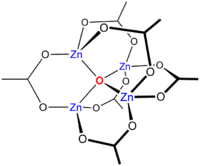Zinc acetate
| Zinc acetate | |
|---|---|
 | |
| IUPAC name Zinc acetate | |
| Other names Acetic acid, Zinc salt | |
| Identifiers | |
| CAS number | 557-34-6 |
| PubChem | 11192 |
| ChemSpider | 10719 |
| UNII | H2ZEY72PME |
| ChEMBL | CHEMBL1200928 |
| RTECS number | ZG8750000 |
| ATC code | A16 |
| Jmol-3D images | {{#if:[Zn+2].[O-]C(=O)C.[O-]C(=O)C|Image 1 |
| |
| |
| Properties | |
| Molecular formula | ZnC4H6O4 (dihydrate) |
| Molar mass | 219.50 g/mol (dihydrate) 183.48 g/mol (anhydrous) |
| Appearance | White solid (all forms) |
| Density | 1.735 g/cm3 (dihydrate) |
| Melting point | Decomposes 237 °C (dihydrate loses water at 100 °C) |
| Boiling point | decomp. |
| Solubility in water | 43 g/100 mL (20 °C, dihydrate) |
| Solubility | soluble in alcohol |
| Structure | |
| Coordination geometry |
octahedral (dihydrate) |
| Molecular shape | tetrahedral |
| Hazards | |
| R-phrases | R22 R36 R50/53 |
| S-phrases | S26 S60 S61 |
| Main hazards | mildly toxic |
| Related compounds | |
| Other anions | Zinc chloride |
| Other cations | Copper(II) acetate |
| Related compounds | Basic beryllium acetate |
| Except where noted otherwise, data are given for materials in their standard state (at 25 °C (77 °F), 100 kPa) | |
| Infobox references | |
Zinc acetate is the chemical compound with the formula Zn(O2CCH3)2, which commonly occurs as a dihydrate Zn(O2CCH3)2(H2O)2. Both the hydrate and the anhydrous forms are colorless solids that are commonly used in chemical synthesis and as dietary supplements. Zinc acetates are prepared by the action of acetic acid on zinc carbonate or zinc metal. When used as a food additive, it has the E number E650.
Basic properties and structures
The acetate group is capable of binding to metal ions in a variety of ways through its two oxygen atoms and several connectivities are observed for the various hydrates of zinc acetate. Anhydrous zinc acetate adopts a polymeric structure consisting of zinc coordinated to four oxygen atoms in a tetrahedral environment, each tetrahedron being connected to neighbors by the acetate groups.[1] The acetate ligands are not bidentate. In contrast, most metal diacetates feature metals in octahedral coordination with bidentate acetate groups. In zinc acetate dihydrate the zinc is octahedral, wherein both acetate groups are bidentate.[2]
Basic zinc acetate
Heating Zn(CH3CO2)2 in a vacuum results in loss of acetic anhydride, leaving a residue of "basic zinc acetate," with the formula Zn4O(CH3CO2)6. This cluster compound has the tetrahedral structure shown below. This species closely resembles the corresponding beryllium compound, although it is slightly expanded with Zn-O distances ~1.97 vs ~1.63 Å for Be4O(OAc)6.[3]

Applications
Dietary and medicinal applications
Zinc acetate has been used in lozenges for treating the common cold. Pooling the results of three high dose zinc acetate trials indicates an average 42% reduction in the duration of colds (Figure).[4]

Zinc acetate is particularly useful salt in lozenges since acetate does not bind zinc, so that essentially all zinc from the lozenges is freely released.[5][6]
Although zinc acetate lozenges shorten the duration of colds, most zinc lozenges on the US market, unfortunately, either have too a low dose of zinc or contain ingredients that tightly bind zinc ions, such as citric acid.[7] Therefore, the great benefit seen in the high dose zinc acetate trials may not be easy to actualize.
Zinc acetate can also be used to treat zinc deficiencies. As an oral daily supplement it is used to inhibit the body's absorption of copper as part of the treatment for Wilson's disease. Zinc acetate is also sold as an astringent in the form of an ointment, a topical lotion; or combined with an antibiotic such as erythromycin for the topical treatment of acne. Furthermore Zinc acetate is commonly sold as a topical anti-itch ointment.
In chewing gum, zinc acetate is a breath freshener[8][9] and plaque inhibitor.[10]
Industrial applications
Industrial applications include wood preserving, manufacturing other zinc salts, polymers, manufacture of ethylene acetate, as a dye mordant, and analytical reagent. It is used in commercial nuclear power plants as a plating inhibitor on primary water piping.
Zinc acetate is a precursor via a sol-gel route to the transparent semiconductor zinc oxide.
References
- ↑ Capilla, A. V.; Aranda, R. A. (1979). "Anhydrous Zinc(II) Acetate (CH3-COO)2Zn". Crystal Structure Communications 8: 795–797.
- ↑ J. N. van Niekerk, F. R. L. Schoening and J. H. Talbot (1953). "The crystal structure of zinc acetate dihydrate, Zn(CH3COO)2·2H2O". Acta Cryst. 6 (8): 720–723. doi:10.1107/S0365110X53002015.
- ↑ Koyama, H.; Saito, Y. (1954). "The Crystal Structure of Zinc Oxyacetate, Zn4O(CH3COO)6". Bull. Chem. Soc. Japan 27 (2): 112–114. doi:10.1246/bcsj.27.112.
- ↑ Hemilä H (2011) Zinc lozenges may shorten the duration of colds: a systematic review. Open Respir Med J 5:51-8 Refs with links: http://www.mv.helsinki.fi/home/hemila/Zn/TORMJ.htm
- ↑ Eby GA (2004) Zinc lozenges: cold cure or candy? Solution chemistry determinations. Biosci Rep 24:23-39
- ↑ Eby GA (2010) Zinc lozenges as cure for the common cold. Med Hypotheses 74:482-92
- ↑ Eby G (2009) Zinc Lozenges as a Common Cold Treatment
- ↑ US 7087255
- ↑ US 6592849
- ↑ Giertsen E, Svatun B, Saxton A (February 1987). "Plaque inhibition by hexetidine and zinc". Scand J Dent Res 95 (1): 49–54. PMID 3470899.